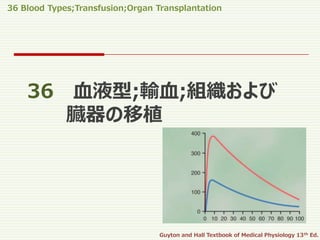
36 blood types,transfusion,tissue and organ transplantation
- 1. 36 Blood Types;Transfusion;Organ Transplantation Guyton and Hall Textbook of Medical Physiology 13th Ed. 36 血液型;輸血;組織および 臓器の移植
- 2. 36 Blood Types;Transfusion;Organ Transplantation Guyton and Hall Textbook of Medical Physiology 13th Ed. 人の血液細胞の表面膜には,良くある抗原 が少なくとも30種類,まれに認められる抗原は 数百種類あり,時に抗原抗体反応を起こす. 抗原の多くは,弱い抗原性しかなく,家系を 遺伝学的に調べる際に重要になる程度である. 二つのタイプの抗原系は輸血反応を起こしや すい. O-A-B 系 Rh 系 血液細胞の多様な抗原性
- 3. 36 Blood Types;Transfusion;Organ Transplantation Guyton and Hall Textbook of Medical Physiology 13th Ed. O-A-B 血液型
- 4. 36 Blood Types;Transfusion;Organ Transplantation Guyton and Hall Textbook of Medical Physiology 13th Ed. A型抗原,B型抗原が多くの人のRBCsの 表面に存在する. 輸血反応を起こすのは,これらの抗原 凝血を起こすので凝集原agglutinogenとも呼 ばれる これらの抗原は遺伝するので,いずれもない か,1つを持つか,両方同時に保持している場 合もあり得る. A,B抗原 (凝集原)
- 5. 36 Blood Types;Transfusion;Organ Transplantation Guyton and Hall Textbook of Medical Physiology 13th Ed. 遺伝子型 血液型 凝集原 凝集素 OO O - 抗A と 抗B OA または AA A A 抗B OB または BB B B 抗A AB AB A と B - O-A-B 血液型
- 6. 36 Blood Types;Transfusion;Organ Transplantation Guyton and Hall Textbook of Medical Physiology 13th Ed. ABO血液型の遺伝子座には,三つの対立遺伝子あ る. IA IB IO Iは,immunoglobulinを表す. IOは,機能が無いため細胞上で,明らかなO型凝集 原を発現しない. 逆に,IA,IBは強い凝集原を発現 する. IOは,IA,IBに対して劣勢 IA,IBは共優性 凝集原の遺伝的決定
- 7. 36 Blood Types;Transfusion;Organ Transplantation Guyton and Hall Textbook of Medical Physiology 13th Ed. O 47% A 41% B 9% AB 3% 各血液型の頻度
- 8. 36 Blood Types;Transfusion;Organ Transplantation Guyton and Hall Textbook of Medical Physiology 13th Ed. A型(もしくはB型)の凝集原がRBCs上に存 在しない場合,血漿内で抗A凝集素(もしくは 抗B凝集素)が発達する. よってO型では,抗A凝集素,抗B凝集素と もに発達する.AB型では,いずれの凝集素も 発達しない. 凝集素 Agglutinins
- 9. 36 Blood Types;Transfusion;Organ Transplantation Guyton and Hall Textbook of Medical Physiology 13th Ed. 年齢と凝集素の濃度 B型,O型血液内の抗A 凝集素 A型,O型血内 の抗B凝集素 凝集素の平均滴定濃度 人の年齢 (年)
- 10. 36 Blood Types;Transfusion;Organ Transplantation Guyton and Hall Textbook of Medical Physiology 13th Ed. gamma globulins ほとんど全て抗体 他の抗体同様骨髄,リンパ腺細胞で産生 ほとんどがIgM,IgG immunoglobulin分子 A型抗原を,非A型の人に輸注すると抗A凝 集素を大量に産生して,典型的な免疫反応を 示す. 新生児は,あっても少量の凝集素しかない. 凝集素の形成は,生後に行われる. 血漿凝集素とは
- 11. 36 Blood Types;Transfusion;Organ Transplantation Guyton and Hall Textbook of Medical Physiology 13th Ed. 異型輸血の際の凝集過程 1. 凝集素がRBCsに付着 2. 凝集素は結合部を複数もつ IgGタイプ 2結合部位 IgMタイプ 10結合部位 3. 一つの凝集素は同時に複数のRBCsを結合 4. この凝集塊が小血管を閉塞する. 5. 数時間から数日後,細胞のゆがみや貪食細胞の攻 撃をうけて凝集細胞の膜が破壊され血色素を放出 →RBCsの溶血 輸血反応の凝集過程
- 12. 36 Blood Types;Transfusion;Organ Transplantation Guyton and Hall Textbook of Medical Physiology 13th Ed. 血液型不適合輸血 流血中に溶血が起きる 抗体が,補体を活性化して蛋白分解酵素(lytic complex)を放出して細胞膜を破壊してRBCsの 溶血を起こす. 凝集素による遅延型の溶血よりは,即時型の血 管内溶血は,はるかに少ない.抗体の濃度が非 常に高い必要があることと,hemolysinと呼ばれ るIgMタイプの抗体が必要なため. 急性溶血
- 13. 36 Blood Types;Transfusion;Organ Transplantation Guyton and Hall Textbook of Medical Physiology 13th Ed. 血清 RBCs型 抗A 抗B O - - A + - B - + AB + + 血液型判定
- 14. 36 Blood Types;Transfusion;Organ Transplantation Guyton and Hall Textbook of Medical Physiology 13th Ed. Rh 血液型
- 15. 36 Blood Types;Transfusion;Organ Transplantation Guyton and Hall Textbook of Medical Physiology 13th Ed. 6種の良くあるRh抗原 Rh因子 C,D,E,c,d,e C抗原を有する人は,c抗原持たない C抗原を持たない人は,常にc抗原を有する. Eとe抗原, Dとd抗原との間も同様の関係にある. Rh因子も遺伝するので,人は必ず3対の抗原のいずれかを保有する. D型抗原がもっとも多くの人に認められ,抗原性も高い. D抗原(+)=Rh(+) D抗原(ー)=Rh(ー) Rh(-)でも,他のRh因子が輸血反応を起こす可能性はある (反応は,非常に軽度ではあるが). Rh(+)の率:米国白人85%,米国黒人95%,アフリカ黒人100% Rh 抗原
- 16. 36 Blood Types;Transfusion;Organ Transplantation Guyton and Hall Textbook of Medical Physiology 13th Ed. 抗Rh凝集素 Rh因子をもたない患者にRh因子を含む RBCsが輸注された場合. 抗Rh凝集素がゆっくり形成,2-4ヶ月後に最高値と なる. 頻回にRh因子に暴露されると,Rh(-)の人はしば しばRh因子に強く感化される. Rh免疫反応
- 17. 36 Blood Types;Transfusion;Organ Transplantation Guyton and Hall Textbook of Medical Physiology 13th Ed. 1. 以前Rh(+)の血液を輸血されたことがないRh(-) 患者の場合,初回のRh(+)血の輸注では,直後の反 応は出現しない. 2. その後の2-4週間の間に,十分量の抗Rh抗体が産 生され,まだ循環している輸血された細胞と凝集を起こ す. 3. 凝集を起こした細胞は,組織マクロファージ系により溶 血される. この遅延型輸血反応は,通常軽度ですむ. 4. すでにRh因子に感作されている人にRh(+)血を輸 注すると,反応は即時に起こり,程度もAB型不適応の 際と同程度の重篤なものになる. Rh輸血反応の特徴
- 18. 36 Blood Types;Transfusion;Organ Transplantation Guyton and Hall Textbook of Medical Physiology 13th Ed. 1. 母親Rh(-),父親(+) 2. 児は,父親からRh(+)の遺伝子を受け継ぐ 3. 母親は,児のRh抗原に暴露されて抗Rh凝集 素を産生 4. 胎盤を通して母親の凝集素が児に拡散 し,RBCの凝集を起こす. 胎児赤芽球症 erythroblastosis fetalis
- 19. 36 Blood Types;Transfusion;Organ Transplantation Guyton and Hall Textbook of Medical Physiology 13th Ed. Rh(-)の母親でも,Rh(+)の第一子では,有 害事象をおこすような凝集反応は認めない. Rh(+)の第二子では,約3%で胎児赤芽球 症を呈する. Rh(+)の第三子では,約10%で症状が出現 する. 以降,妊娠を重ねるにつれて出現率は高 まる. 胎児赤芽球症の出現率
- 20. 36 Blood Types;Transfusion;Organ Transplantation Guyton and Hall Textbook of Medical Physiology 13th Ed. 1. 胎盤を通して,胎児の血液に拡散 2. 胎児の血液を凝集 3. 凝集血液は溶血をおこし,血色素を放出 4. 胎児マクロファージが血色素をビリルビンに変 換 1. 皮膚を黄染する(黄疸) 抗Rh抗体は,他の体細胞も攻撃,傷害す る. 母親の抗Rh抗体
- 21. 36 Blood Types;Transfusion;Organ Transplantation Guyton and Hall Textbook of Medical Physiology 13th Ed. 赤芽球症の児は,黄疸と貧血を呈し,母親からの 抗Rh抗体が,生後1,2ヶ月循環してRBCsをさら に破壊する. 溶血したRBCsを置換するために肝や脾は,胎生 中期のようにRBCsを産生しようとする. 性急なRBCsの生産のため,児の骨髄から流血 中に多くの有核芽球が出現する. →赤芽球症の由縁 予後:貧血による死亡,精神発達遅滞,ビリルビン 蓄積による運動野の障害(核黄疸) 赤芽球症の臨床
- 22. 36 Blood Types;Transfusion;Organ Transplantation Guyton and Hall Textbook of Medical Physiology 13th Ed. Rh(-)血による交換輸血 1.5時間以上かけてRh(-)血を400ml輸血し, 自身のRh(+)血を脱血する. 最初の数週間に数回繰り返す. ビリルビンレベルを低く保ち,核黄疸を予防. 輸血されたRh(-)血は,Rh(+)血に置き換えら れることがある. 母親に由来する抗Rh凝集素が破壊されるまで には,6週以上を要する. 胎児赤芽球症の治療
- 23. 36 Blood Types;Transfusion;Organ Transplantation Guyton and Hall Textbook of Medical Physiology 13th Ed. Rh(-)の母親の妊娠28-30週からRh免疫グ ロブリン グロブリン (抗D抗体)を投与することに より,劇的に減少 抗D抗体は,Rh(+)の児を出産した母親にも投 与する. 次の妊娠時に,大量のD抗体を産生することを防ぐ. 抗D抗体の作用機序は不明? 抗体が誘導するBリンパ球抗体産生抑制 抗D抗体がRh(+)のRBCsの表面に付着し,胎盤を 通して母親の血液に流入し,D抗体にたいする免疫を 阻止. 胎児赤芽球症の予防
- 24. 36 Blood Types;Transfusion;Organ Transplantation Guyton and Hall Textbook of Medical Physiology 13th Ed. 異型輸血により供給血が凝集することがあっ ても,受容者の血液の凝集を起こすことは希. 供給血の血漿部分は受容者の血液にすぐ希釈さ れるため,凝集を起こすには輸注された凝集素の濃 度が低すぎる. 少量の輸血された血液では,受容者の血漿の凝集 素を十分希釈できない. 受容者の凝集素が,誤って輸注された供給血の凝集 を起こす. 異型輸血反応1
- 25. 36 Blood Types;Transfusion;Organ Transplantation Guyton and Hall Textbook of Medical Physiology 13th Ed. 1. hemolysinないし凝集細胞の貪食による 溶血 2. 放出された血色素は,貪食細胞によりビリル ビンに変換 3. ビリルビンは,肝臓から胆汁として排泄 4. 肝臓が正常であれば,血液が400ml以上 溶血しない限り黄疸は出現しない. 異型輸血反応2
- 26. 36 Blood Types;Transfusion;Organ Transplantation Guyton and Hall Textbook of Medical Physiology 13th Ed. 1. 溶血細胞から,強力な腎血管収縮物質が放 出 2. 貧血とショックによる腎血流減少 3. freeのhaptoglobinが結合できる以上の ヘモグロビンが放出されると,糸球体から尿細 管に出たまま濃縮され,尿細管を閉塞する. 異型輸血後,数分から数時間で発症し,透析を しなければ1週間から12日間程度で死亡する. 異型輸血反応3 腎不全
- 27. 36 Blood Types;Transfusion;Organ Transplantation Guyton and Hall Textbook of Medical Physiology 13th Ed. 組織,臓器の移植
- 28. 36 Blood Types;Transfusion;Organ Transplantation Guyton and Hall Textbook of Medical Physiology 13th Ed. Autograft: 同一個体の別の部分に移植 Isograft: 一卵性双生児間の移植 Allograft: 人から人へ,動物から同一種の別の動物へ Xenograft: 異種間の移植 移植のタイプ
- 29. 36 Blood Types;Transfusion;Organ Transplantation Guyton and Hall Textbook of Medical Physiology 13th Ed. human leukocyte antigen(HLA) antigen 移植片拒絶反応を起こす最も重要な抗体6種 150種類の異なるHLAがあり,組み合わせは1兆 種類を超える. 一卵性双生児を除いて,他人間で同一の6種HLA 抗体を持つのは不可能 著明な免疫により拒絶反応が起こりうる. 兄弟,親子間では反応起こりにくい HLA 抗体
- 30. 36 Blood Types;Transfusion;Organ Transplantation Guyton and Hall Textbook of Medical Physiology 13th Ed. 1. Glucocorticoid hormones:T細胞を誘 導し抗体産生を促すIL-2などのサイトカイン をコード化する遺伝子を抑制する. 2. azathioprine:抗体やT細胞の産生にたい して抑制的に働く 3. Cyclosporine,tacrolimus:T-helper cellの形成抑制からT細胞の拒絶反応を抑 制する.他の免疫系を抑制しない点が優れる. 4. 抗リンパ球抗体,抗IL-2受容体抗体 免疫抑制剤
- 31. 36 Blood Types;Transfusion;Organ Transplantation Guyton and Hall Textbook of Medical Physiology 13th Ed. 36 血液型;輸血;組織および 臓器の移植
Editor's Notes
- 出生直後は,血漿内凝集素はほとんどゼロ. 2-8ヶ月の間にA(ないしB)凝集原がない場合には,抗A(ないし抗B)凝集素を作り始める. 凝集素の濃度の最高値は8-10才頃で,その後は一生低下し続ける.